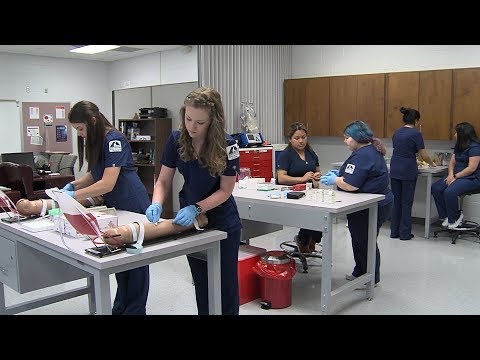What Classes Do You Have to Take for Medical Assistant?
Contents [show]
Medical assistants are crucial members of the healthcare team, providing vital support to doctors and nurses. If you’re thinking of becoming a medical assistant you’re probably wondering what classes you’ll need to take.
Here’s a rundown of the most common courses Medical assistants take, from anatomy and physiology to medical billing and coding.
Checkout this video:
Introduction to medical assisting
Medical Assistants are vital members of the healthcare team. They perform both clinical and administrative tasks in medical offices, clinics, and hospitals.
A medical assistant career can be very rewarding, but it does require a commitment to learning. Most medical assistant programs last about a year, and lead to a certificate or diploma. Some programs may take longer, and lead to an associate’s degree.
Here is a typical list of courses you’ll take in a medical assistant program:
-Anatomy and physiology
-Medical terminology
-Medical office procedures
-Computer applications in healthcare
-Billing and coding
-Medical insurance and reimbursement
-Clinical procedures
-Phlebotomy (drawing blood)
-Laboratory procedures
-Externship (clinical experience)
The role of the medical assistant
Medical assistants are multi-skilled health professionals responsible for performing administrative and clinical tasks in medical offices. As members of the health care team, they work closely with physicians, assisting them in examining and treating patients. MA’s take medical histories, measure patient vital signs, obtain laboratory specimens, perform routine office laboratory tests, prepare patients for X-rays and other diagnostic procedures, give injections, instruct patients about medication and special diets, and collect urine samples.
Medical assistant duties and responsibilities
Medical assistants are allied health professionals who support the work of physicians and other health care providers. They perform administrative and clinical tasks that allow physicians to focus on providing patient care.
Medical assistants typically have a high school diploma or equivalent, although some have completed postsecondary education, and must pass a certification exam to earn their credential. Most states have laws governing the scope of practice of medical assistants.
The duties and responsibilities of medical assistants vary depending on state law, employer, and job setting, but may include taking and recording patient medical histories and vital signs, preparing patients for examinations, assisting with office surgical procedures, scheduling appointments, handling correspondence, billing and collections, coding insurance forms, and ordering supplies.
The medical assistant’s scope of practice
The medical assistant’s scope of practice is determined by the regulations of the state in which they work. In some states, medical assistants may be allowed to perform more advanced tasks such as drawing blood or administering injections; in others, they may only be allowed to perform basic administrative and clinical tasks.
A medical assistant may also be certified by a professional organization such as the American Association of Medical Assistants (AAMA). Certification indicates that the medical assistant has completed a formal training program and passed a standardized examination. Certified medical assistants typically have more job opportunities and may earn higher wages than non-certified assistants.
Education and training requirements for medical assistants
Medical assistants perform many tasks in doctors’ offices, hospitals, and other healthcare facilities. They may work up front, greeting patients and scheduling appointments. Or they may work in the back office, taking patients’ medical histories, recording vital signs, and giving injections. Some medical assistants take X-rays and collect laboratory specimens.
Most medical assistants have postsecondary education such as a certificate. Others have completed a 2-year associate degree in medical assisting. A small number have completed a 4-year bachelor’s degree in another field and then have taken postgraduate courses in medical assisting.
Although most states do not require certification for medical assistants, employers prefer or may require certification. The American Association of Medical Assistants offers the Certified Medical Assistant (CMA) credential. To earn the CMA credential, candidates must graduate from an accredited medical assisting program and pass a national exam.
Certification and licensure for medical assistants
Medical assistants are unlicensed per sonal health care workers who perform patient care and routine administrative tasks in medical offices, clinics, and similar settings. Although certification is not required for all medical assistant jobs, some employers prefer to hire certified medical assistants. To become certified, candidates must pass an accredited program and exams administered by credentialing organizations such as the National Healthcare Association (NHA) or the American Association of Medical Assistants (AAMA). Some states require licensure for medical assistants who perform certain tasks, such as taking X-rays or administering medications.
The medical assistant’s job outlook
In order to become a medical assistant, you will need to have at least a high school diploma or equivalent. You will also need to complete a medical assisting training program that has been accredited by the Commission on Accreditation of Allied Health Programs (CAAHEP) or the Accrediting Bureau of Health Education Schools (ABHES). Once you have completed your accredited training program, you will then need to pass the Certified Medical Assistant (CMA) exam administered by the American Association of Medical Assistants (AAMA).
The medical assistant’s salary and benefits
The medical assistant’s salary and benefits are among the best in the healthcare industry. Medical assistants are in high demand and the demand is only expected to increase in the coming years. Medical assistants typically work in doctor’s offices, clinics, and other healthcare facilities. They perform a variety of tasks, including taking medical histories, performing lab tests, scheduling appointments, and assisting with patient care.
The medical assistant’s career path
Medical assistants are among the most versatile and valuable members of a healthcare team. They perform both clinical and administrative tasks, freeing up the time of physicians and other medical professionals so that they can focus on patient care.
The career path of a medical assistant is an exciting one, with opportunities for growth and advancement. While many medical assistants start their careers with only a high school diploma or GED, many choose to further their education by completing a formal medical assistant program.
Medical assistant programs typically last between six and twelve months and are offered by community colleges, technical schools, and some four-year universities. Upon completion of a medical assistant program, graduates will have the skills and knowledge necessary to sit for the certified medical assistant (CMA) exam. The CMA credential is the gold standard in the medical assistant profession, and earning it can open doors to higher-paying jobs and increased responsibility.
FAQs about medical assisting
Medical assistants are in high demand! If you’re thinking about becoming a medical assistant, you probably have some questions about the field. Here are some answers to frequently asked questions about medical assisting:
What classes do you have to take for medical assistant?
There is no one-size-fits-all answer to this question, as the courses required for medical assisting may vary depending on the program you choose and your prior education. However, most medical assistant programs will include coursework in subjects such as anatomy and physiology, Medical Terminology administrative office procedures, and clinical procedures.
How long does it take to become a medical assistant?
Again, this varies depending on the program you choose and your prior education. However, most medical assistant programs can be completed in 1-2 years.
Is certification required to be a medical assistant?
Certification is not required in all states, but it may be beneficial to your career. Certified Medical Assistants (CMAs) often have an advantage when seeking employment, as many employers prefer or require certification. Additionally, CMAs must complete continuing education credits every few years to maintain their certification, which can help them stay up-to-date on changes in the field ofmedical assisting.







